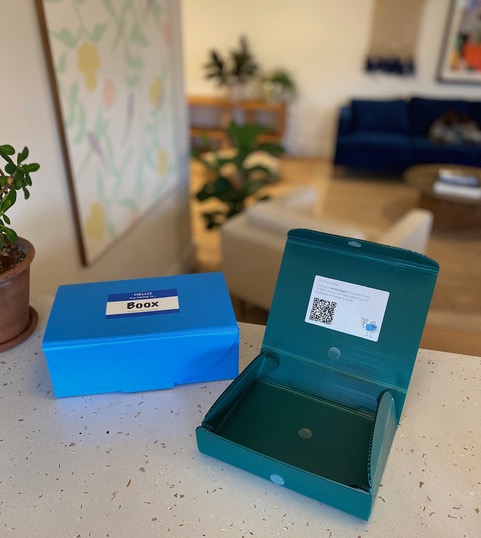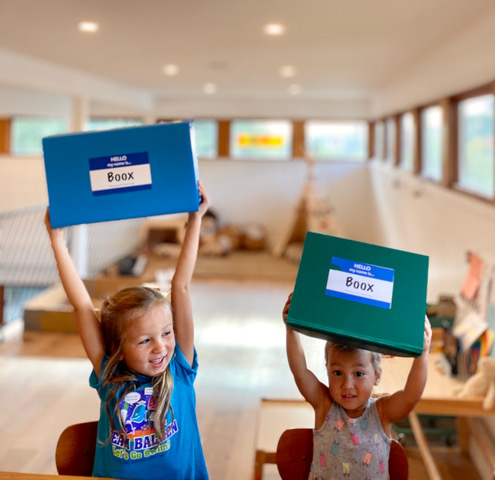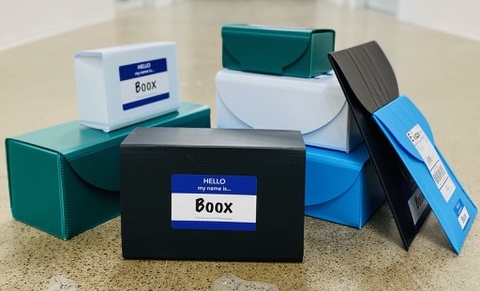Nearly one quarter of our waste is paper and cardboard and with online sales up 32% this year, that means even more cardboard could end up in landfill. Luckily, there are companies coming up with innovative ways to reduce our cardboard waste. We sat down with one of them – Boox CEO Matt Semmelhack – to discuss their reusable shipping box and what it means for the future of cardboard waste.
Q: Can you provide a brief summary of Boox and what the process looks like?
A: Boox is the box you don’t throw away.
Today, most e-commerce companies ship their products in single-use cardboard boxes. 200 Billion will be shipped in 2021!! Our existing infrastructure can’t keep up with the incredible growth of direct-to-consumer shipping. Cardboard boxes are made from trees, and make up a major portion of municipal waste (landfill) in the US and elsewhere.
Boox is a better way to ship — we provide reusable boxes (“Booxes”!) to e-commerce brands that their consumers then return to us for reuse. As a consumer, you simply drop your Boox in the outgoing mail with a pre-paid label directly from your home. No more breaking down boxes or guilt of stuffing your bin every week. Booxes come back to us for reconditioning and distribution back to our partners for reuse, in a closed loop. This circular economy method reduces impact by more than 75% compared to the status quo of cardboard boxes and provides brands and consumers a way to participate in reducing waste related to online shopping.
Q: Can you tell us a bit about the history of Boox and how you got started?
A: I had a 10+ year ‘first career’ opening and managing restaurants in San Francisco and saw firsthand  the waste that is created in that industry—pretty shocking. I went to work for Thistle.co, a mission-driven, plant-based meal delivery company, overseeing logistics and operations. I was surprised (in a good way) to see how many of Thistle’s customers cared deeply about the packaging waste we were sending them, so much so that some canceled their service solely due to the problem. I founded Boox in November 2019 with my co-founder and old friend, Bob Walton, as CTO (with me as CEO). His background includes high-level roles at Facebook and Adobe—he’s a great technical mind and has a great set of complementary skills to me. We agreed to found the company as a B-Corp and to ensure every decision we make is in service of the company mission to reduce waste.
the waste that is created in that industry—pretty shocking. I went to work for Thistle.co, a mission-driven, plant-based meal delivery company, overseeing logistics and operations. I was surprised (in a good way) to see how many of Thistle’s customers cared deeply about the packaging waste we were sending them, so much so that some canceled their service solely due to the problem. I founded Boox in November 2019 with my co-founder and old friend, Bob Walton, as CTO (with me as CEO). His background includes high-level roles at Facebook and Adobe—he’s a great technical mind and has a great set of complementary skills to me. We agreed to found the company as a B-Corp and to ensure every decision we make is in service of the company mission to reduce waste.
We got started humbly, as the Covid pandemic reared its ugly head a few months after we incorporated the company. We have a great support system from Wave Capital, the VC fund that provided capital for our initial fundraising and they gave us a lot of great advice early on and throughout the past 12 months—we honed a rough concept into a full fledged B2B business and physical product in 2020, launching with a handful of e-comm brands in September of this year.
Q: What is the ultimate goal of Boox? What are your company values?
A: The ultimate vision for Boox is a global network of reuse. We imagine a finite number of boxes that carry all of the world’s shipments efficiently around the globe, being reused by companies across all industries. In this future world shipping, boxes are never thrown away, and there’s no need to ever produce a new one or send waste to the landfill. Beyond boxes, we see the same infrastructure working for reusable bags, cups, bottles, etc.
As a B-Corp, our company is dedicated to doing business for good. We are charged with operating a business that puts social and environmental standards above profits and transparently reporting on our progress annually. We’re also members of Climate Neutral and 1% For The Planet and love to work with companies that share these values.
Beyond the social/environmental values, we really think about our business from a consumer-centric angle. Ultimately, if we don’t provide a great experience for individual consumers, the concept doesn’t work. So even though we sell our service B2B, we always put ourselves in the consumers’ shoes when making business and product decisions.
Q: What is the box made of and how did you land on that material for your boxes?
A: Currently, Booxes are made from corrugated polypropylene sheets, using a patent-pending design we came up with. This is produced in the US from a combination of new and post-consumer polypropylene (#5 on the recycled plastics chart – PCR). Our goal is to improve the post-consumer percentage over time, eventually getting to 100% PCR. We’re also experimenting with material made from ocean plastics and other sources.
came up with. This is produced in the US from a combination of new and post-consumer polypropylene (#5 on the recycled plastics chart – PCR). Our goal is to improve the post-consumer percentage over time, eventually getting to 100% PCR. We’re also experimenting with material made from ocean plastics and other sources.
We chose polypropylene (PP) for a variety of reasons— It’s waterproof, tear-proof, and lighter than cardboard, while still being rigid and durable enough to protect products during shipping. That means we can reuse each Boox box many times before they reach the end of life. But, at end of life, PP can be processed back into more Booxes efficiently.
Many people think of plastics as detrimental to the environment. We’d like to encourage people to think differently about it— SINGLE-USE plastics (but really any single-use product) are bad for the environment and can end up in rivers and oceans where they don’t degrade for a long time. But, that same longevity can be put to great use if we can change the culture of consumption and shift towards the circular economy.
Q: How is it better for our environment to use a reusable box over a disposable box or mailer? Can you speak to the reduced carbon emissions by switching to reusable mailers?
A: We recently completed a Life Cycle Analysis (LCA) on the overall impact of the entire Boox process, from “cradle-to-grave” and compared it to the status quo of shipping in cardboard boxes. This was audited by two independent 3rd partners, and I’m really proud of the results: By reusing Booxes, our clients are beginning to reduce their impact after just one single shipment. Even better, after 10 shipments, Boox’s model for reuse cuts the impact from cardboard boxes by a whopping 75%. For some companies, this can be as high as a 90% reduction (depending on the boxes they’re currently using, and the level of consumer participation).
Q: Can you share your current participation rate for returns on those boxes? Are customers actively returning those boxes to you?
A: Yes, though the caveat here is that we’re growing quickly and will have much more data soon. Our early data (2,000 shipments) yielded an 85% return rate. Again, very proud of this (and of the consumers that did the right thing!) as we were really expecting to start at more like 20-25% return rate. We’re encouraged by the fact that such a high percentage of people understand the benefits of reuse, and were willing to change their behavior to participate in reducing waste. As the concept of the circular economy gains traction, we expect to increase the return rate significantly, via community-driven incentives for returns. Ultimately we believe this will simply become how shipping works, and the rate of return will approach 100%.
Q: Can you talk about the customer experience?
A: As e-commerce has grown and more brands are launching without a brick and mortar storefront, the  need for digital engagement is also growing. For brands to differentiate themselves, and to provide great customer experiences, they need more than a cardboard box dropped on the doorstep as it lacks in terms of the brand touch point, voice, or that “wow” factor you might get from visiting a beautiful shop, or chatting with an enthusiastic salesperson that loves the product they sell.
need for digital engagement is also growing. For brands to differentiate themselves, and to provide great customer experiences, they need more than a cardboard box dropped on the doorstep as it lacks in terms of the brand touch point, voice, or that “wow” factor you might get from visiting a beautiful shop, or chatting with an enthusiastic salesperson that loves the product they sell.
Because we invest more into the Boox box itself than a brand would with a cardboard box, we can afford to put more into the physical package. Our QR code system is meant to be the beginning of a “virtual storefront” that brands can use to engage their consumers. It allows us to tailor the digital experience to the consumer and be more dynamic with marketing and engagement than a printed material ever could. It also means brands can ditch those old fashioned postcards, brochures, or catalogs that are really just going to become trash.
Last, in order to maintain an efficient logistics network, and to track our own carbon footprint, we track the Booxes and how many trips they’ve taken via the QR code system. We are excited to expand on this innovation in the future.
Q: What is the incentive for a business to use Boox?
A: The answer is threefold:
- It allows a business to differentiate its brand around the consumer experience. Boox provides so many things that a cardboard box cannot and brands must find ways to stand out from their competition. Boox does this through reduced environmental impact, the digital experience, and saving consumers from breaking down cardboard.
- It reduces a business’s carbon footprint. Whether you’re a B-Corp or just a conscientious brand, reducing your corporate carbon footprint is critical. Consumers, especially Millennials, are increasingly likely to consider sustainability efforts when choosing which brands they identify with and spend money with.
- It simplifies fulfillment and returns. Booxes require no tape to put together and can be assembled in seconds. Since they are more durable than cardboard they can be resealed and sent straight back to brands for merchandise returns, reducing loss, and making for a better consumer experience.
Q: How can businesses use Boox boxes as a marketing tool?
A: The reduced impact of switching to reusables and reducing corporate impact is particularly valuable in industries like apparel, cosmetics, and shoes where the product itself isn’t physically all that different from another brand- really it’s the perception of the brand identity, and how consumers identify with it. If you can stand out to consumers via innovation in sustainability, you’ll acquire more customers and improve brand loyalty. I can’t stress enough how critical this is going to become as an expectation for consumers, especially younger ones. Further to this point, in many countries, legislation has already been passed requiring brands to use circular practices going forward. It’s just a matter of time (and more planet-friendly politicians) before single-use items are banned.
Additionally, Boox provides a virtual storefront concept. We don’t yet have the data to prove it, but anecdotally we know that an engaging digital experience will lead to happier, more loyal consumers. We’re just beginning to see brands thinking about fun ways to turn this into a tool for conversion and increased sales via fun live streams, social networking, referrals, promos, points-based loyalty, and fun tech like augmented reality (AR). The sky is really the limit on creative uses of digital marketing with Boox acting as the conduit between brands and consumers.
And don’t undervalue the benefit that Boox stands out in the mountain of brown cardboard. We hear over and over from consumers that they love the bright, happy color and the surprise of receiving something NOT in cardboard! Then they’re even happier when they discover they don’t have to break down the box and are a part of a closed-loop program!
Q: Can you share any specific case studies?
A: Not exactly case studies, but three good anecdotes:
Charix Shoes
We work with a shoe brand called Charix Shoes, based in DC. They have a beautiful Turkish-style loafer. Suley, the founder, told me he gets incredibly frustrated with the number of cardboard boxes used for an average order. Since shoes are so size-specific, they’re frequently exchanged for a slightly different size. Suley sends one of their branded cardboard boxes with a size 9, inside another cardboard shipping box (that’s two boxes, already). The consumer loves them, but needs a 9.5. That consumer will send the size 9 back in a random cardboard box (box three) he has lying around, and throw away the Charix shipping box. Suley then has to re-stock that pair of shoes (hopefully still in good condition) and dispose of the box, then send another cardboard shipping box (box four) to the consumer, with a cardboard shoe box inside it (box five). That’s FIVE cardboard boxes heading for the trash in a single transaction! Boox developed both an interior product box and an exterior shipping box to replace Charix’s boxes— now when merchandise gets returned, it goes back in the same Boox boxes, and when the customer does keep the merchandise, he can return the used boxes to Boox to be used again. Multiply this by 10,000 transactions a year, which is a relatively small e-comm business, and Boox just saved 50,000 cardboard boxes from being trashed.
REN Skincare
We recently ran a pilot with REN Skincare, a sustainable skincare brand. They sent a bunch of Booxes out to influencers with product. We’ve been seeing these amazing social media videos where the consumer pops open her Boox, takes a look at the REN product, then focuses the camera on the Boox box and says how amazing it is that REN Skincare is being so innovative with packaging. What I love about this is that the consumer response is overly enthusiastic about REN’s brand, and Boox is able to prop that up. When you’re sending something relatively simple, like skin cream, and your customer gets excited about the box it comes in, you know you’re doing something right!
Blue Ledge Farm
We work with a dairy farm in Vermont that makes amazing cheeses, called Blue Ledge Farm. The owner, Hannah, was hesitant about switching to a new type of box, and potentially increasing her costs, so she decided to go with our “Opt In” option. There’s a little radio button on the checkout page of her website where consumers can “Opt In” to the Boox service for a small fee. We’ve been pleasantly surprised to see how many of her customers are opting in, suggesting that they’re grateful to have a more environmental option to cardboard, and are willing to pay for it themselves! This reveals the community-effort required to transition to the circular economy. We can all play a part.
Subscribe to rts.com today to learn about more innovative companies or chat with one of TRUE Advisors for information on how to take your business zero waste.

